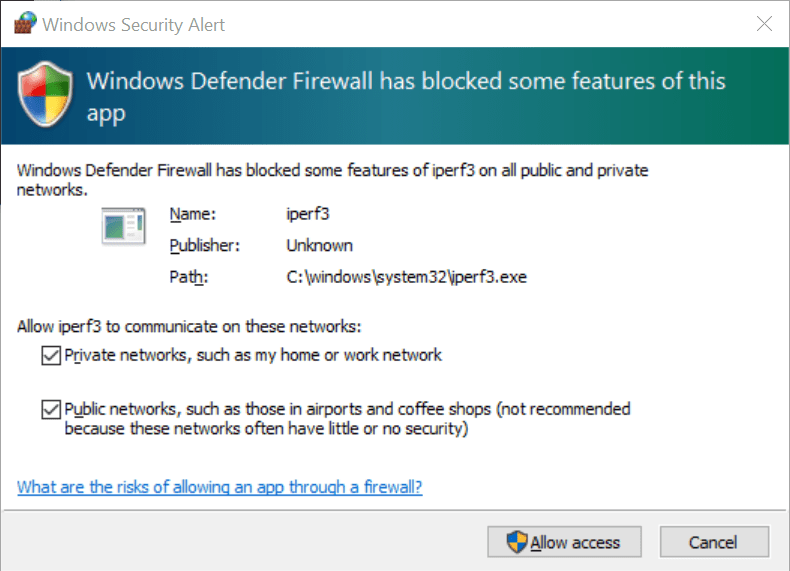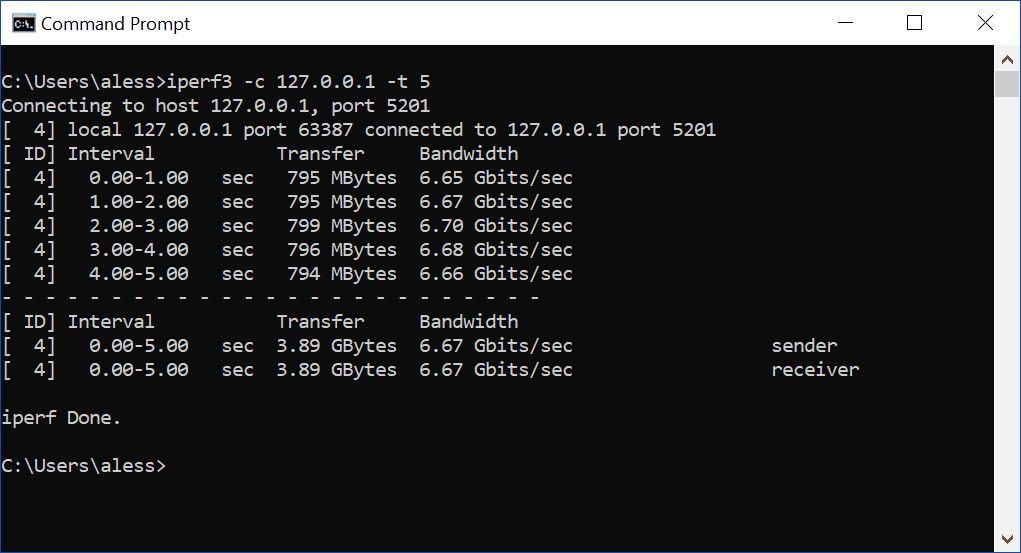How To Use Iperf3 Windows
When you purchase an Internet link, you want to see if you get what y'all're paying for. If you want to exercise that at habitation, you can use many speed examination services. Popular examples are the Speedtest by Ookla, by Telstra, or by Verizon. However, those methods are not reliable enough for an enterprise. Furthermore, y'all can only exam Internet speed, and not speed on internal/private circuits. That'southward why, at the enterprise level, we use iperf (actually iperf3), a powerful and gratis tool. In this tutorial, we will see how to utilise iperf to verify the speed of any link, reliably.
Getting started with iperf
What is iperf?
Iperf is a control-line tool that allows you to test the bandwidth, any way yous similar. Dissimilar online speed tests, you have to provide both server and customer. In other words, when doing an online speed test, yous connect to a server on the Internet, owned by the provider of the test (like Ookla). Then, the application measures the network functioning between you and such a server. Instead, with iperf, you have to set up your ain iperf server. Don't worry, yous don't need special hardware, yous only need to run a control from your prompt. In fact, you can have both the server and the customer on the same estimator.
The reward of running your ain server is predictability. You know where the server is, and you may echo the test in the time to come. That'due south not the case with online services, where they classify you a server dynamically. This ways you won't be able to reproduce the same exam in the future if you do an online speed test. Since you place the server whenever you want, yous can also take it on your internal network and thus test internal links.
Getting iperf
The sable version of iperf is iperf3. It is free software (BSD license) you lot can download from iperf.fr. In a blitz? Hither is a quick link to the download page. You will detect an iperf for whatever operating system and architecture you need. In this guide, nosotros are using iperf3 on Windows (64 bit), merely the tutorial on how to apply iperf is the same for any Os.
If yous are on Windows like me, yous will get a compressed ZIP file. Extract information technology, and if you want to practice things faster re-create its content into C:\Windows\System32. This way, you will always have iperf3 at hand equally a command on the prompt. If you don't do that, y'all will need to motility to the folder where you have iperf before you can give the command.
How to use iperf
Once nosotros have iperf, we need to learn how to use it. As we mentioned in a higher place, we need to run both server and client. The server volition keep listening, accepting client connections. Thus, this is the starting time thing we demand to do. Running the server is every bit simple every bit writing iperf3 -southward in the prompt (-south stands for server). The start fourth dimension y'all practise that, on Windows, it will ask you network permission. Of course, flag the permissions and click Allow access.

One time you enable the access, a simple message will appear on the prompt, telling you that the server is ready to have connections. By default, iperf3 listens on port 5201.

Now, nosotros volition leave the server exist. This server will have all our connections. Withal, we volition be able to tweak the tests and even airplane pilot the server from the iperf client. That's where the real deal is.
A simple speed test with iperf
At present, how to apply iperf3 to run a simple speed examination? You tin can only employ the iperf3 -c command, of course replacing "<server IP>" with the IP of your server. However, we want to accept a better test. Thus, we want to give TCP all the time information technology needs to expand the window size: better to run a test for some more than seconds. We can do that with the -t option, followed by the number of seconds. This will tell iperf3 how long to run the test. By and large, 1 to two minutes are enough (just to show, we will utilize v seconds). Since our server is running on the same PC, the target IP will be localhost at 127.0.0.1, only that's but the instance of this demonstration.

If nosotros want to know how to use iperf, nosotros need to know how analyze the output. The standard output is a table with four columns. Furthermore, the final two rows of the tabular array (after the dash line) stand for the totals.
- ID is the ID of the iperf performance
- Interval is the time span the row refers to
- Transfer is the amount of data exchanged between client and server. In the end, speed test is about transferring files and measuring how long it took.
- Bandwidth is the measured bandwidth
Why don't we have a single total/summary row? Considering we want to see the different performances betwixt sending and receiving. In fact, on the far right of the summary rows, yous volition run into sender and receiver bandwidth. In our instance, the sender is the client so information technology ways the upload speed. Instead, receiver ways download speed. The two might not be ever the same, in case of asymmetric bandwidth.
Other cool options
And so far so skilful. In fact, you lot know how to utilize iperf past only using the commands to a higher place. However, y'all may want to use some options to tweak the measurement at your liking. If yous want to know all options, apply --assist. Here, we will see the well-nigh useful ones.
-
-Pcreates Northward parallel connections, useful to push links to their limit -
-Rruns in reverse mode: the server volition transport and the client will receive -
-bindicate a limit bandwidth (for example 10k, 5mb, 1gb). The exam won't go much across this value, even if the link has higher capacity. -
-Jgenerates the output in JSON once the operation finishes, useful if you want to utilize iperf in scripts.
Try to experiment combining all the options y'all'd like together. You lot volition achieve enterprise-class professional person bandwidth testing.
Decision (and TL;DR)
Iperf3 is a powerful tool to run custom and reliable bandwidth tests. In fact, information technology is perfect for enterprise-grade requirements. If y'all want to know how to apply iperf, yous need only 2 basic commands. Starting time, run a server on a device with iperf3 -s. So, on some other device run iperf3 -t lx -c . This will measure the bandwidth betwixt the two on a period of lx seconds, which is big enough to get a real measurement.
What practise you think nearly iperf? Do you see yourself using it, instead of using the tools available online? Allow me know your opinions in the comments.
How To Use Iperf3 Windows,
Source: https://www.ictshore.com/networking-fundamentals/how-to-use-iperf/
Posted by: adamsmeman1981.blogspot.com


0 Response to "How To Use Iperf3 Windows"
Post a Comment